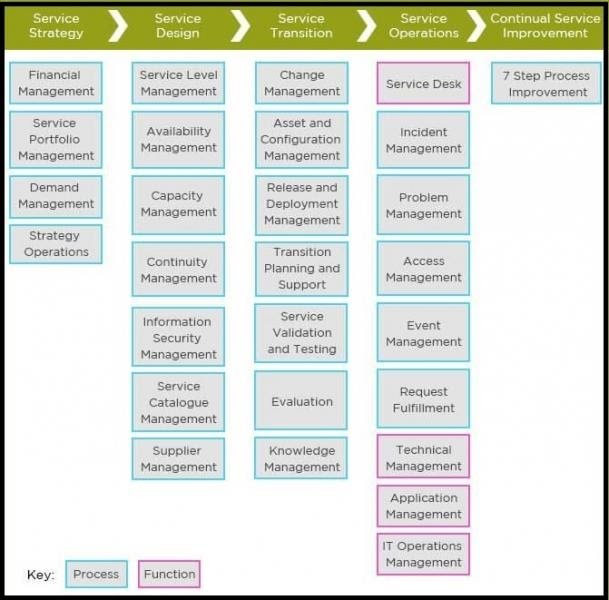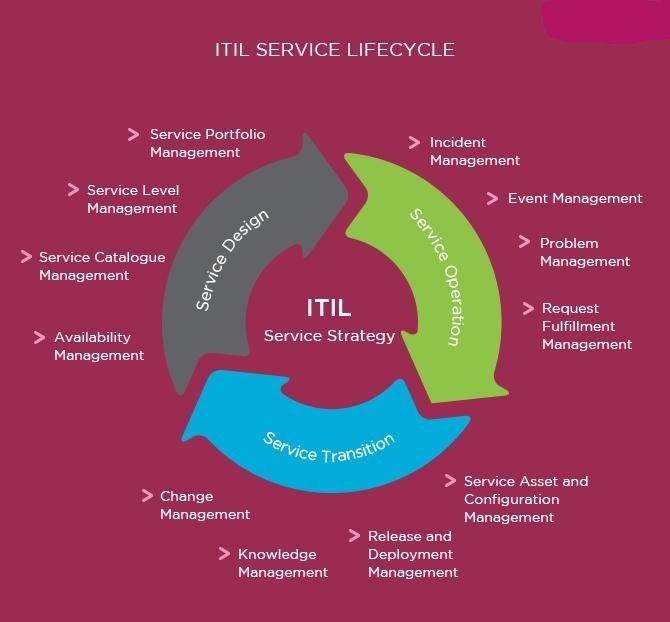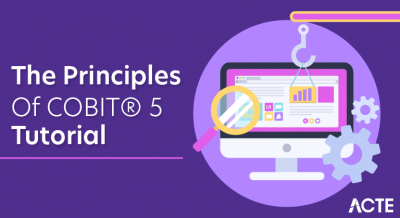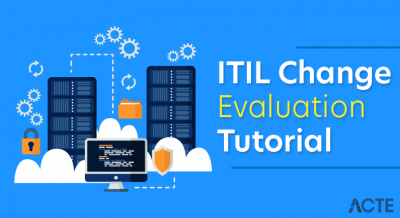
ITIL
ITIL stands for Information Technology Infrastructure Library. It is a set of best practices for delivering IT services—it standardizes the selection, planning, delivery and support of IT services to maximize efficiency and maintain predictable levels of service. It has roots going back to the 1980s in the United Kingdom as a government initiative, and the framework is now covered in five books that are updated periodically. (There were originally 30 books!)
Key ITIL Terms
Capabilities
The specialized skills or abilities an organization applies to resources in order to create value.
Functions
Self-contained subsets of an organization intended to accomplish specific tasks. They usually take the form of a group of people and the tools they use.
Processes
Structured sets of activities designed to achieve a specific objective. The four basic characteristics of processes are:
- They transform inputs into outputs
- They deliver results to a specific customer or stakeholder
- They are measurable
- They are triggered by specific events
Resources
The raw materials that contribute to a service, such as money, equipment, time and staff.
Roles
Defined collections of responsibilities and privileges. Roles may be held by individuals or teams.
Service Assets
Also known just as assets, these refer to the resources and capabilities that a service provider must allocate to offer a service.
Service Management
Specialized capabilities for delivering value to customers in the form of services.
Services
A means of delivering value to customers without requiring them to own specific costs and risks.
Value, Utility, and Warranty
The value of the service consists of two components: utility and warranty. Services must offer both utility and warranty to have value. Utility, also called fitness for purpose, refers to the ability of the service to remove constraints or increase the performance of the customer. Warranty, also called fitness for use, is the ability of the service to operate reliably.
Concepts of ITIL
ITIL have several key principles that are realized through five core components. Some key concepts/principles of ITIL are:
- Delivering maximum value to customers
- Optimizing resources and capabilities
- Offering services that are useful and reliable
- Planning processes with specific goals in mind
- Defining roles clearly for each task.
Before we get to the five core components, let’s define some important ITIL terms.The five large components of the ITIL Service Lifecycle cover various subcategories/features, together with Demand Administration, Capacity Administration, Release Administration, Incident Administration, Event Administration, and so forth. These are elements that are supposed to cover all areas of ITSM (IT Service Administration).
so forth. These are elements that are supposed to cover all areas of ITSM (IT Service Administration).

Every of the sub-categories/features of the five components of the ITIL framework could also be labeled both as a ‘Course of’ or as an ‘Operate.’
ITIL Framework Life Cycle
The framework of ITIL is divided into five broad stages or categories:
- Service Strategy
- Service Design
- Service Transition
- Service Operation
- Continual Service Improvement

Now on to the ITIL frameworks.
1. Service Strategy
The purpose of Service Strategy is to provide a strategy for the service lifecycle. The strategy should be in sync with business objectives. The utility and warranty of this component are designed to ensure that the service is fit for purpose and fit for use, respectively. Ensuring this is important, as these two components are what add value to the delivery of services to customers.
As mentioned above, each major category has subcategories. Within the category of Service Strategy, there are four subcategories.
a) Service Portfolio Management
The Service Portfolio is the entire set of services under management by a service provider. It consists of three major parts: Service Pipeline, Service Catalog, and Retired Services. Service Portfolio Management organizes the process by which services are identified, described, evaluated, selected and chartered.
b) Demand Management
The Demand Management process is concerned with understanding and influencing customer demand. It involves User Profiles, which characterize different typical groups of users for a given service, and Patterns of Business Activity, which represent the way users in different user profiles access a service over the course of a given time period.
c) Financial Management
The Financial Management process provides a means of understanding and managing costs and opportunities associated with services. It includes three basic activities:
- Accounting
Tracking how money is spent by a service provider - Budgeting
Planning how the money will be spent by a service provider - Charging
Securing payment from customers for services provided
d) Strategy Operations
Strategy Operations ensure that services such as fulfilling user requests, resolving service failures, fixing problems and carrying out routine operational tasks are performed efficiently and effectively.
2. Service Design
The Service Design lifecycle phase is about the design of services and all supporting elements for introduction into the live environment. The “Four Ps of Service Design” represent areas that should be taken into consideration when designing a service. They are:
- People
Human resources and organizational structures required to support the service - Processes
Service Management processes required to support the service - Products
Technology and other infrastructure required to support the service - Partners
Third parties that offer additional support required to support the service
There are seven processes included in Service Design.
a) Service Catalog Management
The Service Catalog is a subset that contains services available to customers and users. It is often the only portion of the Service portfolio visible to customers. It commonly acts as the entry portal for all information services in the live environment.
b) Service Level Management
Service Level Management is charged with securing and managing agreements between customers and the service provider regarding the level of performance (utility) and level of reliability (warranty) associated with specific services. Service Level Management results in the creation of Service Level Agreements (SLAs) between customers and the provider. Operational Level Agreements (OLAs) are performance agreements nearly identical in nature to SLAs.
c) Availability Management
The Availability Management process is concerned with the management and achievement of agreed-upon availability requirements as established in Service Level Agreements. In ITIL, “availability” is defined as “the ability of a system, service or configuration item to perform its function when required.”
d) Capacity Management
Capacity Management is concerned with ensuring that at all times, the cost-effective capacity exists that meets or exceeds the needs of the business as established in Service Level Agreements. In ITIL, “capacity” is defined as “the maximum throughput a service, system or device can handle.” Capacity Management is divided into three major activities:
- Business Capacity Management (BCM)
- Service Capacity Management (SCM)
- Component Capacity Management (CCM)
e) Service Continuity Management
The Service Continuity Management process (ITSCM) ensures that the service provider can always provide the minimum agreed-upon levels of service. IT Service Continuity Management uses techniques such as Business Impact Analysis (BIA) and Management of Risk (MOR). It results in the production of the IT Service Continuity Plan, which is an aspect of the overall Business Continuity Plan.
f) IT Security Management
IT Security Management focuses on protecting five basic qualities of information assets:
- Confidentiality
Assurance that the asset is available only to appropriate parties - Integrity
Assurance that the asset has not been modified by unauthorized parties - Availability
Assurance that the asset may be utilized when required - Authenticity
Assurance that the transactions and the identities of parties to transactions are genuine - Nonrepudiation
Assurance that transactions, once completed, may not be reversed without approval
g) Supplier Management
Supplier Management is charged with obtaining value for money from third-party suppliers. It plays a very similar role to that of Service Level Management, but with respect to external suppliers rather than internal suppliers and internal/external customers. Supplier Management handles supplier evaluation, contract negotiations, performance reviews, renewals, and terminations.
3. Service Transition
The objective of the Service Transition process is to build and deploy IT services, making sure that changes to services and Service Management processes are carried out in a coordinated way.
In this phase of the life cycle, the design is built, tested and moved into production to enable the business customer to achieve the desired value. This phase addresses managing changes: controlling the assets and configuration items (the underlying components, such as hardware and software) associated with the new and changed systems, service validation, testing and transition planning to ensure that users, support personnel and the production environment have been prepared for the release to production. There are seven processes within the category of Service Transition.
a) Change Management
The objective of this processing activity is to control the lifecycle of all the changes with minimum disruption to IT services.
b) Evaluation
The objective of the Evaluation process is to assess major changes, such as the introduction of a new service or a substantial change to an existing service before those changes are allowed to proceed to the next phase in their lifecycle.
c) Transition Planning and Support (Project Management)
This process focuses on planning and coordinating the use of resources to deploy a major release within the predicted cost, time and quality estimates.
d) Release and Deployment Management
The objective of this process is to plan, schedule and control the movement of releases to testing and live environments, ensuring that the integrity of the live environment is protected and that the correct components are released.
e) Service Validation and Testing
This process ensures that deployed releases and the resulting services meet customer expectations, and verifies that IT operations are able to support the new service.
f) Service Asset and Configuration Management
The objective is to maintain information about configuration items required to deliver an IT service, including their relationships.
g) Knowledge Management
The objective is to gather, analyze, store and share knowledge and information within an organization, improving efficiency by reducing the need to rediscover knowledge.
4. Service Operations
This stage focuses on meeting end-users’ expectations while balancing costs and discovering any potential problems. The Service Operations process includes fulfilling user requests, resolving service failures, fixing problems and carrying out routine operational tasks. This is the only category of the five that has functions as well as processes. There are five processes and four functions.
a) Event Management (process)
The objective is to make sure configuration items (CIs) and services are constantly monitored and to filter and categorize events in order to decide on appropriate actions.
b) Incident Management (process)
The objective is to manage the lifecycle of all incidents, returning the IT service to users as quickly as possible.
c) Request Fulfilment (process)
The objective is to fulfill service requests, which in most cases are minor changes (for example, requests to change a password) or requests for information.
d) Access Management (process)
The objective is to grant authorized users the right to use a service while preventing access to unauthorized users. The Access Management process essentially executes policies defined in Information Security Management. It is sometimes also referred to as Rights Management or Identity Management.
e) Problem Management (process)
The objective is to manage the lifecycle of all problems, preventing incidents from happening and minimizing the impact of incidents that cannot be prevented. Proactive Problem Management analyzes incident records and uses data collected by other IT Service Management processes to identify trends or significant problems.
f) IT Operations Management (function)
The objective is to monitor and control the IT services and their underlying infrastructure, executing day-to-day routine tasks related to the operation of infrastructure components and applications. This includes job scheduling, backing up and restoring, print and output management, and routine maintenance.
g) Service Desk (function)
This is the point of contact between users and the service provider. A service desk usually handles communication with the users and also manages incidents and service requests.
h) Application Management (function)
Application Management is responsible for managing applications throughout their lifecycle.
i) Technical Management (function)
Technical Management provides technical expertise and support for the management of the IT infrastructure.
5. Continual Service Improvement (CSI)
The objective of this stage is to use methods from quality management to learn from past successes and failures. It aims to continually improve the effectiveness and efficiency of IT processes and services in line with the concept of continual improvement adopted in ISO 2000. There is only one process in this area, and it has seven steps:
- Identifying improvement strategies
- Defining what will be measured
- Gathering data
- Processing data
- Analyzing data
- Presenting and using the information drawn from the data
- Using the information to improve
Conclusion
The globally acknowledged ITIL qualification is going to be the most desired prerequisite for IT project manager jobs in 2018 and after. The above detailed ITIL concepts, core components, benefits and career scope make it simple to understand why the ITIL certification is the most preferred choice of experienced IT professionals poised to boost their competency level. ITIL certification ensures that all the team members understand all the aspects of service management holistically and not just the tasks assigned to them. The online and classroom training for different level ITIL certification, great help for ITIL certification preparation; so, don’t wait – explore your options.
To recap, there are five main stages of ITIL: Service Strategy, Service Design, Service Transition, Service Operations, and Continual Service Improvement. Each of those stages has subcategories of processes. The Service Operations category has functions as well as processes. All of the ITIL processes and stages work together to maximize efficiency and reliability of services and to ensure continual improvement of services.





